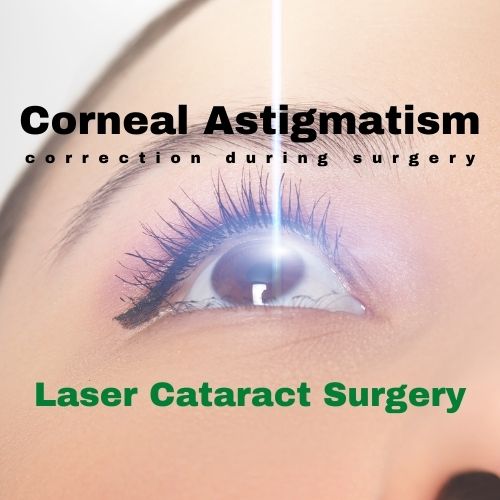Corneal Astigmatism Correction During Cataract Surgery


Corneal astigmatism can be corrected, if needed, with the femtosecond laser during laser cataract surgery. Not all astigmatism needs to be corrected, but doing so may improve the chances of having superior uncorrected vision (without the need for glasses). This articles serves as an outline and should be used only for a reference when you are talking to your eye physician.
This is part of a series of articles we are publishing to inform and educate our patients about the advantages of laser cataract surgery.
There are several steps of cataract surgery. These are the steps of laser cataract surgery where the laser is very useful.
Corneal astigmatism can be corrected, if needed, with the femtosecond laser during laser cataract surgery. Not all astigmatism needs to be corrected, but doing so may improve the chances of having superior uncorrected vision (without the need for glasses). This articles serves as an outline and should be used only for a reference when you are talking to your eye physician.
This is part of a series of articles we are publishing to inform and educate our patients about the advantages of laser cataract surgery.
There are several steps of cataract surgery. These are the steps of laser cataract surgery where the laser is very useful.
- Corneal Incision
- Capsulorhexis (capsulotomy)
- Removal of the Cataract
- Implantation of the Intraocular Lens
- Treat Astigmatism
What is Corneal Astigmatism?
Strictly speaking, corneal astigmatism is irregular curvature of cornea. Ideally, the corneal should be round or spherical like a baseball. Eye with astigmatism are irregular in one meridian, such as football (American football).
Astigmatism can cause blurry vision, halos and glare. Most blurry vision can be corrected by glasses, but results can vary as not all symptoms of astigmatism can be addressed successfully.
Correcting Astigmatism During Laser Cataract Surgery
Astigmatism can be corrected at the time of cataract surgery when using the femtosecond laser.
At the close of any cataract surgery, incisions, or cuts, can be made in the peripheral cornea to reshape the curvature of the cornea. These incisions, called limbal relaxing incisions (LRI), will reduce the astigmatism. The length, size and depth of the incisions vary depending upon the amount of astigmatism.
Experienced cataract surgeons have the ability to manually create the limbal relaxing incisions with a diamond blade.
By using the femtosecond laser, the surgeon can create the limbal incisions with precision. The use of the laser increases the chances of successful vision improvement with astigmatism correction.
Gregory Scimeca, M.D.
Ophthalmologist and Medical Director
The Eye Professionals
Our Locations
